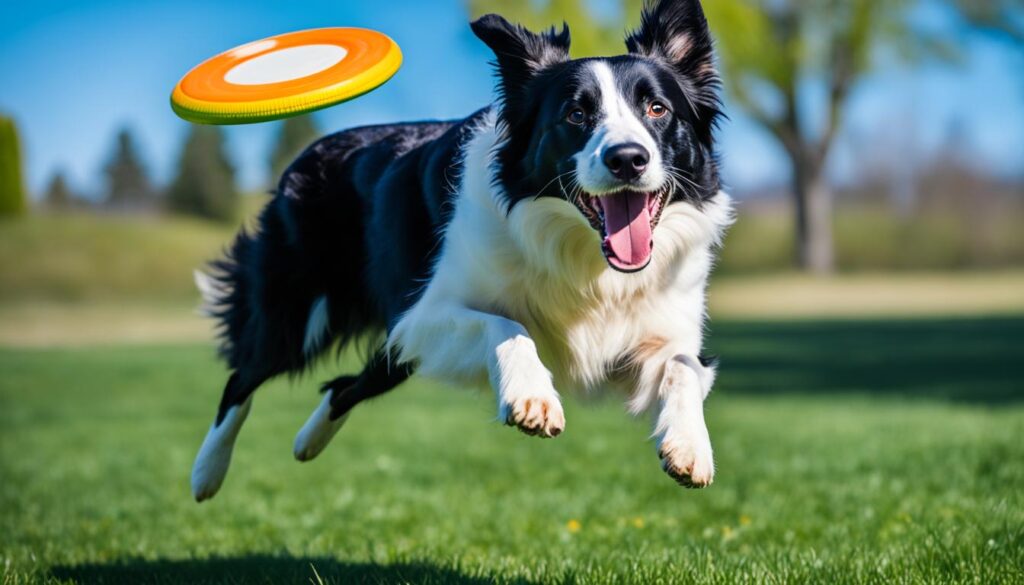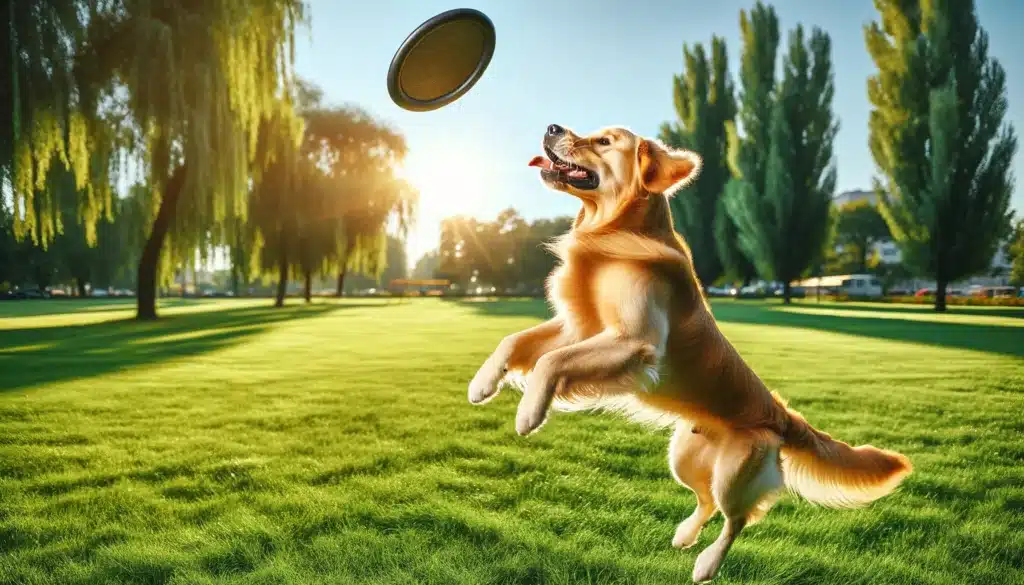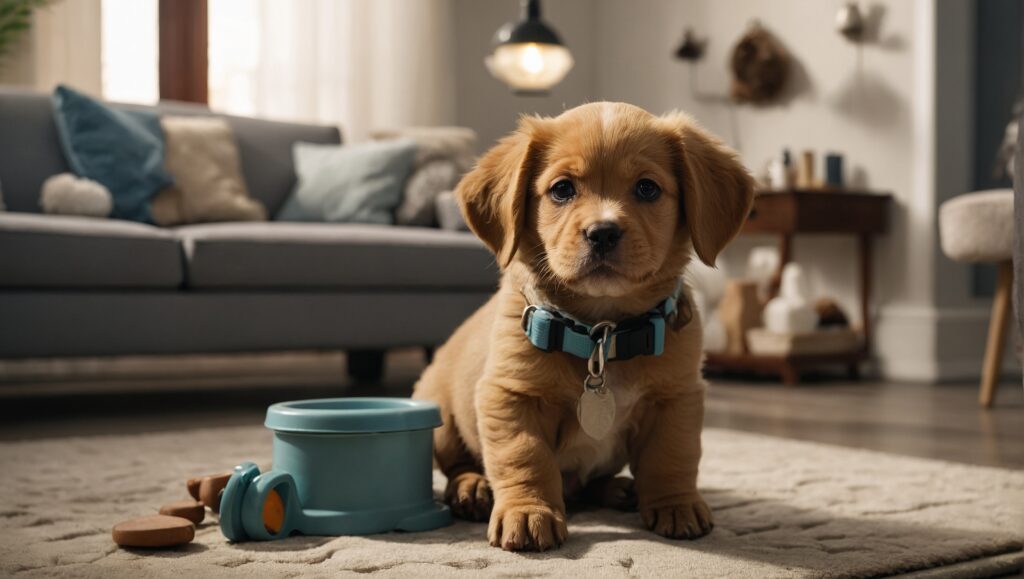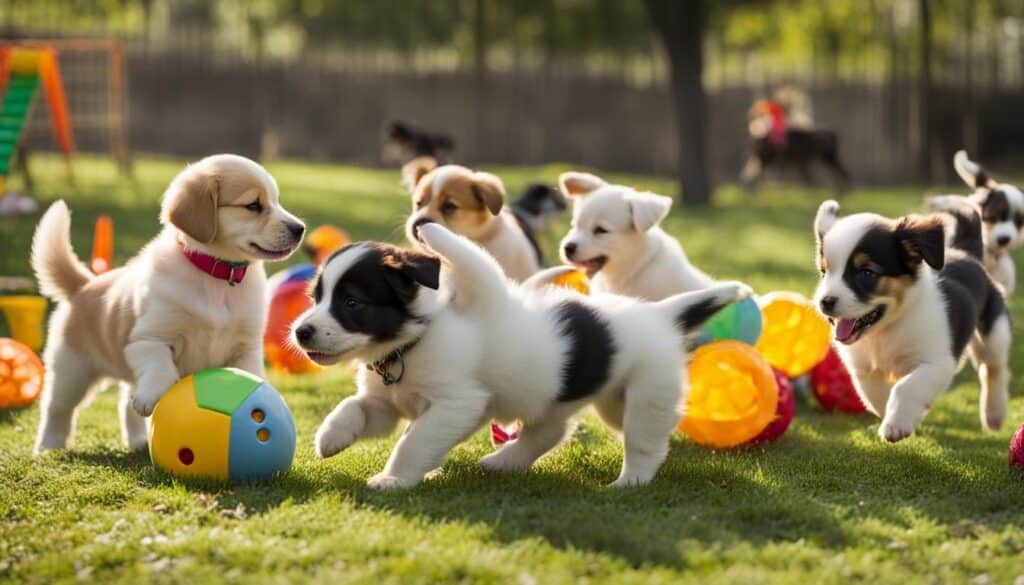Are you looking for a fun and engaging activity with your furry companion? Why not unlock the joy of a disc dog and teach your dog to catch a frisbee? Not only is it a thrilling sport for dogs, but it also brings immense happiness to their owners.
Disc dog activities offer numerous benefits for your dog’s physical health and the bond you share. By engaging in this exciting dog sport, you can provide your canine friend with much-needed exercise and mental stimulation. Furthermore, training your dog to catch a frisbee strengthens the bond between you and your furry friend.
Is your dog ready to embark on the journey of frisbee-catching? Before you start, choosing the suitable frisbee for your dog’s safety and enjoyment is essential. Consider the disc’s dog-friendly features, size, and weight, ideal for your furry friend, and the material’s durability to ensure long-lasting playtime.
With a suitable frisbee, it’s time to begin the training process. Start with basic techniques, gradually transitioning from traditional fetch games to frisbee play. Make the frisbee enjoyable to your dog and encourage them to chase and catch it step-by-step.
As your dog becomes more proficient, you can explore advanced training techniques, teaching them to leap and catch the frisbee with precision and style. You can even incorporate tricks and flips, adding excitement to your disc dog sessions.
During training, it’s crucial to prioritize safety and prevent joint injuries. Implement warm-up routines to prepare your dog’s muscles before playtime, be vigilant in recognizing signs of exhaustion and injury, and follow tips for safe play and training sessions.
If you and your dog enjoy frisbee-catching, why not take it further and engage in disc dog competitions? Discover the different types of disc dog sports available and prepare your dog for the exhilarating challenge of competition. You may even become part of a professional disc dog team!

Key Takeaways:
- Teaching your dog to catch a frisbee can bring joy and happiness to you and your furry friend.
- Disc dog activities boost your dog’s physical health and strengthen your bond.
- Choosing the suitable frisbee ensures safety and enjoyment during playtime.
- Basic training techniques gradually introduce your dog to frisbee-catching.
- Advanced training techniques enhance your dog’s skills and excite your disc dog sessions.
- Stay safe during training by implementing warm-up routines, recognizing signs of exhaustion and injury, and following safety tips.
- Engaging in disc dog competitions opens up a new world of thrilling challenges and opportunities.
Why Teach Your Dog to Catch a Frisbee?
Teaching your dog to catch a frisbee is not just a fun game but also comes with many benefits. Engaging in disc dog activities can boost your canine’s physical health, strengthen your bond with your dog, and introduce your furry friend to a fun-filled dog sport.
Boosting Your Canine’s Physical Health
Disc dog training involves high-energy activities that can provide your dog with much-needed exercise. Your dog will stay active and burn off excess energy by running, jumping, and catching the frisbee. This physical exertion is beneficial for weight management and helps improve cardiovascular endurance and muscle strength.
Strengthening Your Bond With Your Dog
Teaching your dog to catch a frisbee requires teamwork and cooperation between you and your furry companion. Through positive reinforcement-based training, you can communicate and bond with your dog on a deeper level. This shared activity builds trust, enhances obedience, and strengthens your emotional connection with your dog.
Introducing Your Dog to a Fun-Filled Dog Sport
Disc dog sports, such as Frisbee competitions and freestyle routines, offer a fun-filled and engaging experience for you and your dog. These sports provide a platform for showcasing your dog’s skills and abilities while offering plenty of entertainment. Engaging in disc dog sports adds variety and excitement to your regular playtime routine, keeping you and your dog mentally stimulated and engaged.
By teaching your dog to catch a frisbee, you’re enriching their life and opening up a world of opportunities for both of you. The physical health benefits, the strengthened bond, and the introduction to a thrilling dog sport make frisbee-catching an incredible and rewarding endeavor.
Choosing the Right Frisbee for Your Dog
To ensure a safe and enjoyable experience for your furry friend, it’s crucial to choose the suitable frisbee that suits their needs. A dog-friendly disc that is safe for use should be a top priority. Consider the following factors when selecting the perfect frisbee for your canine companion:
Safety First: Selecting a Dog-Friendly Disc
When choosing a frisbee for your dog, prioritize their safety. Look for discs specifically designed for dogs and made with durable and non-toxic materials. These discs are often softer and more flexible, reducing the risk of injury to your dog’s mouth or teeth during play. Opt for frisbees without small parts or sharp edges, which could potentially harm your furry friend.
Size and Weight: Finding the Perfect Match for Your Canine
Consider your dog’s size and breed when selecting a frisbee. Dogs have different jaw sizes and abilities, so choosing a disc that matches their physical capabilities is essential. Smaller dogs may struggle with larger frisbees, while larger dogs may need a more robust disc to handle their power and strength. It’s advisable to consult with a veterinarian or professional trainer to determine the appropriate disc size for your dog.
Material Matters: Ensuring Durability and Enjoyment
Opt for frisbees made from durable materials to ensure longevity and maximize your dog’s enjoyment during playtime. Look for discs that can withstand rough play and won’t easily break or get damaged. For durability, such as rubber or high-quality plastic are commonly used in dog-friendly frisbees. Investing in a durable frisbee will provide long-lasting entertainment and save you money in the long run.

Frisbee Types and their Characteristics
| Frisbee Type | Characteristics |
| Standard Plastic Frisbees | Lightweight and convenient to throw. Ideal for beginners and dogs who enjoy chasing and catching. |
| Soft Fabric Frisbees | Gentler on a dog’s mouth and teeth. Suitable for dogs that prefer a softer catch. |
| Durable Rubber Frisbees | Designed for heavy chewers. Can withstand tough play and vigorous chewing. |
| Glow-in-the-Dark Frisbees | Ideal for playing in low-light conditions or during nighttime. Provides enhanced visibility. |
| Floatable Frisbees | Designed for water activities. Floats on water and easily visible for water retrieves. |
Basic Training Techniques to Get Started
Teaching your dog to catch a frisbee can be a fun and rewarding experience for both of you. Getting started with the proper training techniques is essential to ensure success. This section will guide you through the basic steps of training your dog to catch a frisbee.
From Fetch to Frisbee: Teaching the Basics
To begin, it’s helpful to transition your dog from traditional fetch games to frisbee play. Start introducing the frisbee as a new toy during your regular fetch sessions. Encourage your dog to interact with the frisbee by sniffing, pawing, or picking it up. Use positive reinforcement, such as treats or praise, to reward your dog for showing interest in the frisbee.
Making Your Dog Interested in the Frisbee
To make your dog more interested in the frisbee, you can use “flirt pole training.” Attach the frisbee to a long rope or pole and move it around playfully, mimicking the flight and movement of a frisbee. This will grab your dog’s attention and build excitement for chasing and catching the frisbee.
Step-by-Step: Encourage Your Dog to Chase the Frisbee
Now that your dog is familiar with the frisbee and has shown interest in it, it’s time to encourage them to chase and catch it. Follow these step-by-step instructions:
- Start in a quiet, enclosed space, such as a backyard or a park with a secure fence.
- Hold the frisbee in your hand and show it to your dog, letting them sniff it.
- Give the frisbee a gentle toss just a few feet away.
- Encourage your dog to chase after the frisbee using enthusiastic verbal cues or a favorite toy.
- If your dog shows interest in the frisbee but doesn’t pick it up, reward them with a treat or praise.
- Gradually increase the distance of the toss as your dog becomes more comfortable and confident.
- With each successful catch, reward your dog with praise and plenty of positive reinforcement.
Remember to be patient, and always end each training session positively. Each dog learns at their own pace, so tailoring the training to your dog’s needs and abilities is essential. With consistent practice and positive reinforcement, your dog will soon catch the frisbee with joy and excitement!
| Benefits of Basic Training Techniques | How it Helps |
| Improved coordination and agility | Your dog will learn to track and intercept the frisbee mid-air, enhancing their physical skills. |
| Enhanced bond between you and your dog | The training process strengthens the trust and communication between you and your furry companion. |
| Increased mental stimulation | Learning new skills keeps your dog’s mind engaged and prevents boredom. |
| Opportunity for outdoor exercise | Catching a frisbee provides an excellent cardiovascular workout for your dog, helping them maintain a healthy weight and overall fitness. |
Advanced Dog Training: Teaching Your Dog to Leap and Catch
Once your dog has mastered the basic frisbee-catching skills, it’s time to take their training to the next level. Advanced dog training techniques will help your canine companion develop the timing and technique to leap and catch the frisbee with precision and style. This section will guide you through the steps required to elevate your dog’s disc dog abilities and introduce the thrilling world of tricks and flips in competitive disc dog sports.
Timing and Technique: Teaching Your Dog When to Jump
Timing is crucial when teaching your dog to jump and catch a frisbee. Start by identifying the ideal moment to release the disc. Observe your dog’s movements during the catching process and anticipate when they are at the peak of their leap. This will ensure they have enough time to react and catch the frisbee effortlessly. Use verbal cues and hand signals to guide your dog’s timing and reinforce the correct behavior.
Incorporate drills and exercises that focus on enhancing your dog’s jumping abilities. Set up hurdles or small obstacles to practice jumping over while simultaneously catching the frisbee mid-air. This will improve your dog’s agility and coordination, enabling them to perform more complex catching maneuvers.
Building Confidence and Precision in Catching the Frisbee
Building confidence in catching the frisbee is essential for your dog to excel in advanced disc dog training. Gradually increase the distance and height of your throws to challenge your dog and build their confidence in making challenging catches. Start with shorter throws and gradually progress to longer distances and higher throws as your dog becomes more comfortable and adept at catching the frisbee.
Focus on reinforcing precise catching techniques. Teach your dog to track the disc with their eyes and position themselves correctly to make successful catches. Use positive reinforcement techniques such as treats and praise to reward your dog’s accuracy and consistency in catching the frisbee. Patience and consistency are essential during this stage of training, as it may take time for your dog to develop the necessary skills and confidence.
Incorporating Tricks and Flips for Competitive Disc Dog Sports
Consider incorporating tricks and flips into their repertoire to add excitement and complexity to your dog’s disc dog performance. These advanced maneuvers will impress spectators and challenge your dog’s cognitive and physical abilities.
Teach your dog various tricks, such as spinning, jumping through hoops, and performing flips on command. Integrate these tricks into your frisbee-catching routine, creating a captivating and dynamic display of coordination and teamwork. Use positive reinforcement and clicker training methods to encourage your dog’s willingness to learn and perform these advanced tricks.
Remember to prioritize your dog’s safety and well-being during advanced training. Always start with foundational skills and gradually progress to more intricate tricks and flips. Regularly assess your dog’s physical condition, ensuring they can perform these advanced maneuvers without risk of injury.
By incorporating advanced training techniques, timing and technique, and tricks and flips into your dog’s disc dog training regimen, you’ll elevate their skills to new heights. Your dog will delight in the thrill of leaping and catching frisbees with precision and confidence, and you’ll both enjoy the challenge and excitement of competitive disc dog sports.

Avoiding Common Injuries During Training
Warm-Up Routines for Your Dog Before Playing Frisbee
Before engaging in disc dog training, ensuring that your dog’s muscles and joints are properly warmed up is crucial. Incorporating warm-up routines into your playtime sessions can help prevent injuries and optimize your dog’s performance. Warm-up exercises are essential for preparing your dog’s muscles and increasing blood flow to the joints, which helps prevent strains and sprains.
A tremendous warm-up routine for a disc dog includes:
- Gentle stretching exercises for the legs and back
- Short walks or light jogging to increase heart rate
- Engaging in low-impact play like tug-of-war or gentle fetching
Recognizing Signs of Exhaustion and Injury
During disc dog training sessions, being vigilant and recognizing signs of exhaustion and injury is essential. Dogs may not always show obvious signs of pain, so observing their behavior closely is crucial. If you notice any of the following signs, it’s essential to take a break and seek veterinary attention if necessary:
- Lameness or limping
- Unusual fatigue or reluctance to continue playing
- Difficulty getting up or lying down
- Abnormal swelling, redness, or warmth in the joints
- Whimpering or yelping when touched
Tips for Safe Play and Training Sessions
To ensure the well-being of your dog during disc dog training, follow these tips for safe play and training sessions:
- Choose an appropriate playing surface, such as grass or a soft mat, to minimize the impact on joints.
- Use a frisbee specifically designed for dogs to reduce the risk of injury.
- Avoid high-impact jumps or excessive repetitive movements that can strain your dog’s muscles and joints.
- During intense play and training sessions, provide plenty of water breaks to hydrate your dog.
- Take regular breaks and allow your dog to rest to prevent exhaustion.
Engaging in Disc Dog Competitions
Disc dog competitions provide an exciting platform for showcasing your dog’s skills and teamwork. Whether you’re a seasoned competitor or just starting out, these events offer a perfect opportunity to bond with your dog and demonstrate disc dogs’ impressive athleticism and intelligence.
Disc Dog Sports: Exploring the Various Types
Disc dog competitions encompass various sports and events, each with unique challenges and rules. Here are some of the most popular disc dog sports:
- Freestyle: This is a creative discipline where handlers choreograph routines accompanied by music, showcasing their dogs’ agility, speed, and catching abilities.
- Distance/Accuracy: This sport focuses on the handler’s ability to throw the disc accurately while the dog shows off their skills in catching it over long distances.
- Time trials: In this high-energy format, dogs compete to complete a course quickly, navigating obstacles and catching discs.
- Athletic events: These events highlight the physical abilities of the dogs, including long jump and vertical jump competitions.
Exploring the different types of disc dog sports allows you to find the discipline that suits your dog’s strengths and interests.
Preparing Your Dog for Competition: A Dog Trainer’s Advice
Preparing your dog for disc dog competitions requires dedication and consistent training. Here are some tips from professional dog trainers to help you get started:
- Build a strong foundation: Focus on basic obedience training and teaching your dog solid fundamental skills, such as reliable recalls, fetching, and targeting.
- Conditioning and fitness: Engage your dog in regular exercise and conditioning routines to ensure they are physically fit and ready for the rigorous demands of competition.
- Develop a consistent training routine: Set aside regular practice sessions to work on specific disc dog skills, including catching, retrieving, and obstacle navigation.
- Seek expert guidance: Consider joining a disc dog training class or seek advice from experienced trainers who can help you fine-tune your training techniques and ensure proper form and safety.
Always prioritize your dog’s well-being and make training sessions fun and positive to enhance their enthusiasm and motivation.
The Path to Becoming a Professional Disc Dog Team
For those aspiring to take their disc dog journey to the next level and become a professional disc dog team, there are several steps to consider:
- Continuous training: Commit to ongoing discipline-specific training to master advanced techniques and refine your dog’s skills.
- Participate in local competitions: Gain experience and exposure by competing in local disc dog events to assess your performance and identify areas for improvement.
- Network with fellow enthusiasts: Attend disc dog competitions, seminars, and workshops to connect with other passionate individuals and learn from their experiences.
- Professional guidance: Seek mentorship and guidance from established professional disc dog teams who can provide advice and support on your journey to professionalism.
Becoming a professional disc dog team requires perseverance, dedication, and a love for the sport. Embrace the challenges and learning opportunities along the way, and you’ll be on your path to success.
Conclusion
Teaching your dog to catch a frisbee can unlock a world of joy and excitement for you and your canine companion. Throughout this article, we have explored the many benefits of disc dog activities, highlighting how they can boost your dog’s physical health, strengthen your bond, and introduce you to a fun-filled dog sport.
By selecting the suitable frisbee for your dog and using proper training techniques, you can ensure a safe and enjoyable experience. Starting with basic training techniques, you can gradually progress to advanced skills, such as teaching your dog to leap and catch. Avoiding common injuries during training, warming up before play, and recognizing signs of exhaustion or injury is essential.
Engaging in disc dog competitions is an exciting opportunity to showcase the skills you and your dog have developed. Whether you aspire to compete professionally or prefer the thrill of casual play, the world of disc dog sports offers many possibilities.
In conclusion, teaching your dog to catch a frisbee opens possibilities for you and your furry friend. From physical exercise to mental stimulation, the joy and fulfillment of frisbee-catching activities are undeniable. So why wait? Start your disc dog journey today and discover the endless adventures that await you and your canine companion.

